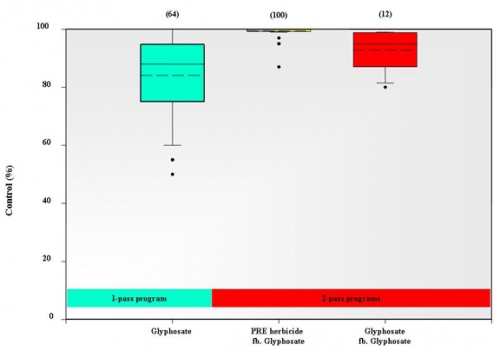Weed control in soybeans can benefit from preemergence soil-applied herbicides
Editor’s note: This article is from the archives of the MSU Crop Advisory Team Alerts. Check the label of any pesticide referenced to ensure your use is included.
The
use of postemergence (POST) glyphosate in Roundup Ready soybeans has
been the primary weed control program used by many Michigan soybean
growers. While this system has seemed to simplify weed management,
relying on total postemergence herbicide programs can be difficult to
manage if not properly implemented. The flexibility in application
timing that glyphosate offers may make it easier to control larger
weeds, however the benefits of early-season weed control to protect crop
yield can be lost if applications are not made in a timely manner.
Additionally, untimely applications can lead to a reduction in weed
control. Another thing to consider is by relying only on glyphosate as
the weed control strategy. This system puts tremendous selection
pressure on the weeds that could possibly lead to the development of
herbicide-resistant weeds.
One way to help overcome some of these concerns is to implement the use
of a soil-applied or preemergence (PRE) herbicide into your soybean weed
control program. Using a planned PRE residual herbicide followed by a
POST glyphosate application can result in more consistent weed control,
reduces the size and number of weeds present at the POST application
timing, and offers greater flexibility in the POST application window.
One of the concerns that many producers have in implementing a PRE
herbicide is the economics. While a PRE herbicide may increase the cost
of your weed control program, resulting benefits often make up for the
cost by increasing weed control and yield. Below are some of the
benefits realized by PRE followed by POST weed control programs.
Reduced early-season weed competition
Using a PRE herbicide will control a number of weeds that would
have emerged and competed with the crop as it becomes established. While
early-season competition may not be a factor if the POST application is
timed appropriately, (remember that weeds can increase in size in a
number of days and if you are trying to spray a large number of acres or
you become delayed in your applications due to rain) early-season weed
competition can become a problem. Remember, for timely POST applications
to avoid yield losses due to early-season weed competition MSU
recommends weeds should be controlled before they are 4-inches in height
in 7.5- and 15-inch rows and 6-inches in height in 30-inch rows.
Consistent control of weeds that continually emerge
Several weed species have continual emergence or emerge only
later in the season. These species can include: annual grasses, giant
ragweed (southern Michigan), eastern black nightshade, pigweeds and
common lambsquarters (occasionally). Because of the later emergence of
these weeds they may actually emerge after the POST herbicide
application and can produce seed and become a problem at harvest. PRE
herbicides allow for a delay in the POST applications, which will result
in more effective control of these late-emerging weeds.
Consistent control of hard-to-control weeds
In Michigan, we have seen a few weeds that have become harder to
control with one POST glyphosate application. Common lambsquarters and
giant ragweed are examples of weeds that are not always effectively
controlled with glyphosate. A PRE herbicide can aid in control by
providing effective control or suppression of these weeds, so they are
easily controlled with the POST application. For example, over severalMSU trials a PRE residual herbicide followed by POST glyphosate
treatment has provided more consistent control of common lambsquarters
than 1- or even 2-applications of glyphosate (Figure 1).
Effective control of perennials
Control of perennial weeds is more effective in the later stages
of growth (bud to flower stage). Because PRE residual herbicides will
provide initial control of annual weeds, the POST glyphosate application
may correspond more appropriately to the stage of growth needed for
perennial weed control.
Weed resistance management
One possible long-term benefit from including a PRE herbicide in
your weed control program is the implementation of herbicide resistance
management strategies. A PRE herbicide would include another mode of
action into the weed management program and reduce the number of weeds
present for the POST application. Ultimately, these two benefits will
relieve the selection pressure of a glyphosate-only weed management
system. This has become a much greater concern as we see more
glyphosate-resistant weeds being reported around the United States.

Figure 1. Consistency
of common lambsquarters control with three different types
of herbicide programs in soybeans. A 2-pass program that consisted of a soil-applied
or preemergence (PRE) herbicide followed by glyphosate (POST) was more
consistent
in controlling common lambsquarters than either one or
two-postemergence applications
of glyphosate.
( ) = Number of observations for each treatment.
This data is a compilation of 6 years of research trials conducted at Michigan State University (C. Sprague, 2005).



 Print
Print Email
Email


